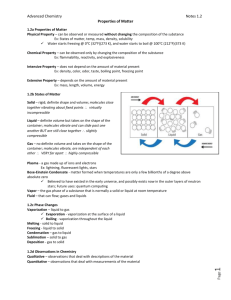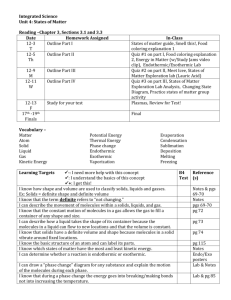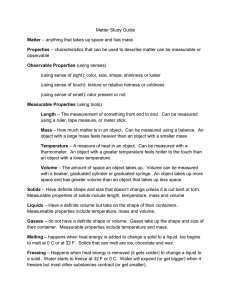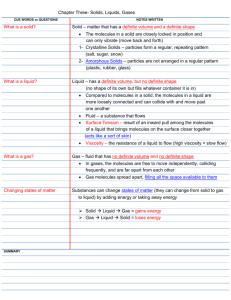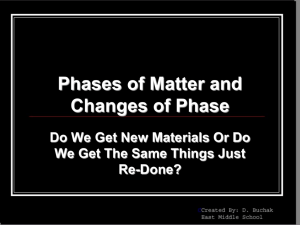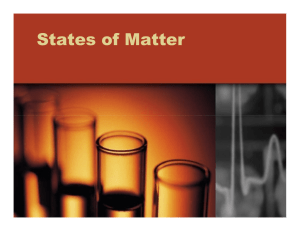States of Matter
advertisement
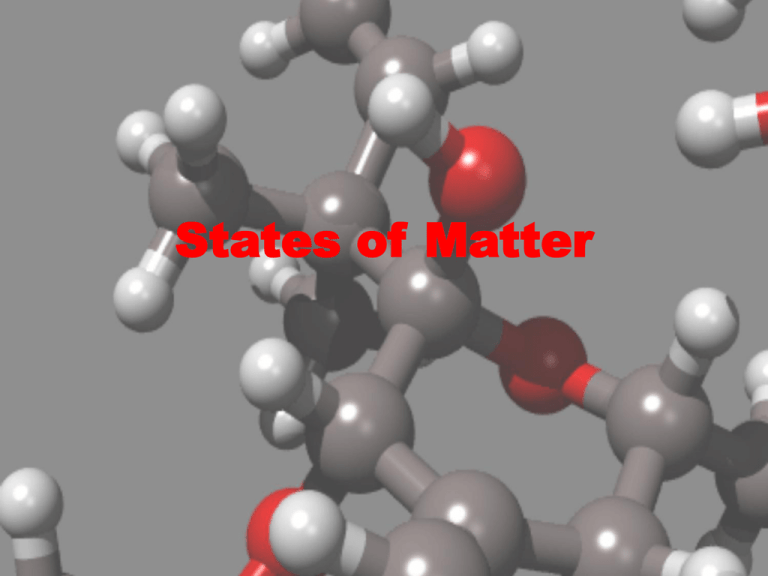
States of Matter How does thermal energy affect the state of a substance? • Thermal Energy interactive Video – Investigate at home • Video molecules in motion Temperature • Temperature is the average kinetic energy of the atoms/molecules in a system. • Temp. measures how “hot” something is. Temperature Scales • Fahrenheit (English system) – Water freezes at 32⁰ F and boils at 212⁰ F. • Celsius – freezing point of water is 0⁰ C, and boiling point is 100⁰ C. • Kelvin (scale that is based on energy content) – At zero Kelvin (absolute zero) all molecular motion stops. – Scientists have figured out a way to get a temperature only a few billionths of a degree above absolute zero. 4 States of Matter • Matter can move from one phase to another. • When temp. goes up, matter becomes more excited and active. • As the temperature rises, matter moves to a more active state. 4 States/Phases of Matter • • • • Solids Liquids Gases Plasmas What is a solid? • Solids have a – definite shape – definite volume. – Molecules are tightly packed – Cannot move freely, can only vibrate – Energy and temp. are very low Solids are broadly characterized as • Crystalline Solids- Repeating pattern Examples Ghost crystals Salt Copper Sulfate crystals in rocks rock candy • Amorphous Solids- - Non-repeating pattern Examples Wax hand putty Gum play dough peanut butter clay What is a liquid? Liquids have • no definite shape (take shape of container in which it is held) • Definite volume. • Molecules are closely packed, but move more than in a solid • Energy and temp. are higher than in solids What is a Gas? • Have indefinite and unstable shape • No definite volume, volume determined by container • Molecules are far apart and have lots of freedom of movement. • Energy and temperature are higher than those of both solids and liquids. • Gases diffuse (move from higher concentrations to lower) – Heat will increase the rate of diffusion. What is plasma? • Ionized Gas-- a cloud of protons, neutrons and electrons where all the electrons have come loose from the atoms • This is an extreme gas! Strikes the other atoms so forcefully it knocks off an electron! • Particles are very far apart and moving like CRAZY! • Super-heated, superexcited! Neon Signs Plasma Examples Our Sun, the core of stars Lightning Plasma TV Aurora Borealis plasma balls Plasma Cutters A Phase Change • A "phase" describes a physical state of matter. – If energy is added (like increasing the temperature) or if energy is taken away (like freezing something), you have created a physical change. A Phase Change • A compound or element can move from one phase to another, but still be the same substance. • It may require extreme temperatures or extreme pressures, but it can be done. Melting SOLID LIQUID • Melting Point - the temperature at which matter changes from solid to liquid, (e.g. The melting point of water from ice to liquid water is 0 °C) Evaporation LIQUID GAS • Boiling a liquid to form a gas is called vaporization. Super Heated Steam Video https://www.youtube.com/watch?v=yFnNK9fNdls Evaporation How does evaporation differ from vaporization? Vaporization, Boiling, Evaporation Boiling vs. Evaporation Sublimation SOLID GAS Examples: Mothballs in closet Dry ice Condensation GAS LIQUID Examples: Glass of ice water Bathroom mirror after shower Dew on grass. Freezing or Solidification LIQUID SOLID Water is the only known substance that expands as it freezes. Most substances contract. Deposition GAS SOLID Examples: Frost on glass- Water vapor becoming a solid Pressure and Phase Change • If lowering the temperature won’t get a liquid to change to a solid just apply pressure. • By applying pressure you are “pushing” the molecules together. Thermal Expansion • Thermal expansion is the tendency of a matter to change in volume in response to a change in temperature. Examples: Sidewalk cracking Bridges Demo – Hand Boiler Heating and Cooling Curves • Heating Curve Link
